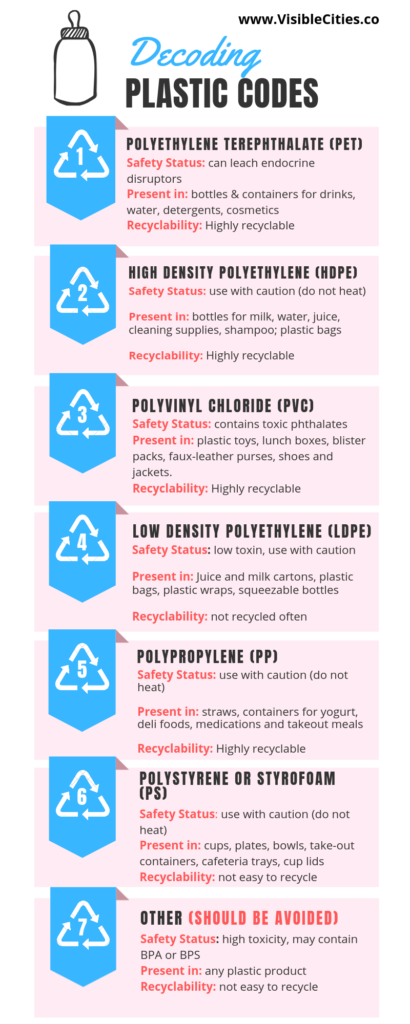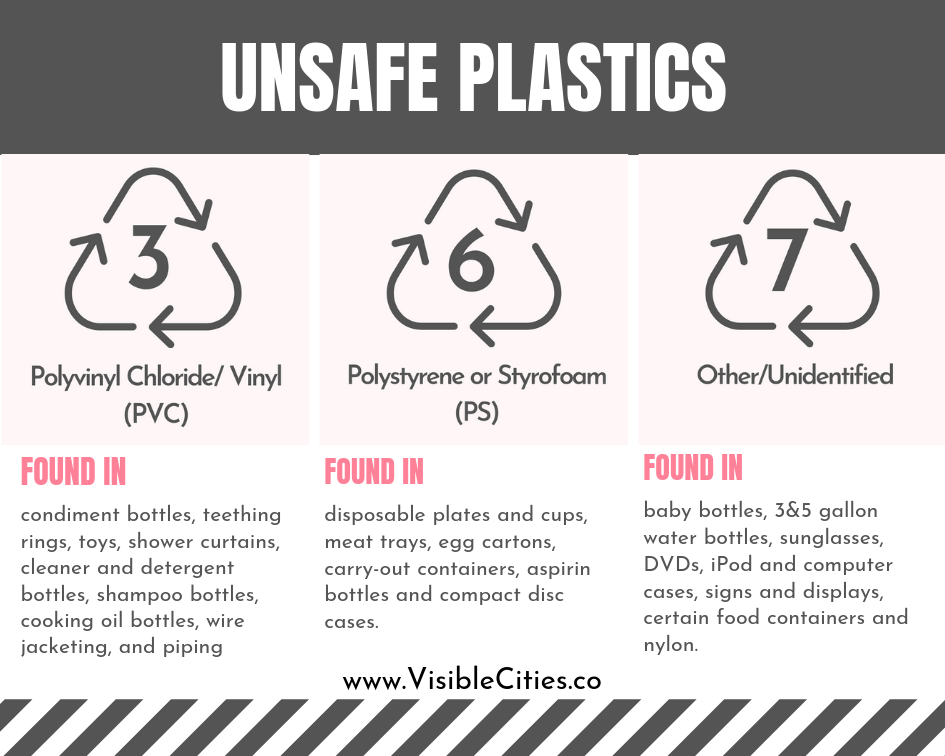Things Nobody Told You About Plastic Bottles
On the bottom of each plastic product, you will notice a number encased in a triangular recycling sign. This number notifies what kind of plastic was used to make the product. This number ranges from 1 to 7 and called the Resin Identification Code can tell you whether the plastic is safe to use or not.
Why you should check the code
There are 2 benefits of knowing this plastic code.
First, it tells you what type of plastic it is and whether it has any unbidden chemicals that may render it unsafe for personal use.
Second, it helps you understand how to dispose of it once it has been used.
Which Plastics to Avoid

Safe Plastics
Symbols 2, 4, and 5 are considered to be the safest. While Number 1 is considered safe, it is also best to avoid this plastic (it can actually leach the toxic metal antimony, which is used during its manufacture).
Unsafe Plastics

POLYVINYL CHLORIDE (PVC) or Plastic 3
Commonly known as vinyl. We are inured to using PVC in the form of condiment bottles, teething rings, toys, shower curtains, cleaner and detergent bottles, shampoo bottles, cooking oil bottles, clear food packaging, wire jacketing, medical equipment, siding, windows and piping.
PVC may seem innocuous, but contains the notorious phthalates: plasticizers when off-gassed, can be inhaled, ingested or absorbed through the skin.
Phthalates are linked to a host of human health issues like asthma, attention-deficit hyperactivity disorder, breast cancer, obesity and type II diabetes, low IQ, autism spectrum disorders, and male fertility issues.
BBP, DBP, and DEHP are types of phthalates that are banned from toys and children’s products in the US and Europe.
POLYSTYRENE or Plastic 6
Commonly known as Styrofoam, these plastics are found in disposable plates and cups, meat trays, egg cartons, carry-out containers, aspirin bottles and compact disc cases. Their utility lies in their ability to keep foods and liquids hot.
Styrofoam cups when heated can release potentially toxic breakdown products like styrene into your coffee or tea.
Number 6 plastics are also one of the most difficult plastics to recycle.
Other or Plastic 7
The so-called “miscellaneous” plastic, No. 7 is a catch-all for various types of plastics, including those found in baby bottles, three and five-gallon water bottles, ‘bullet-proof’ materials, sunglasses, DVDs, iPod and computer cases, signs and displays, certain food containers and nylon.
Number 7 plastics may contain Bisphenol A (BPA), a synthetic estrogen that could disrupt the human hormone system, causing various health issues.
BPA and Toxicity

BPA is a starter material for the widely used polycarbonate plastic. As a material, BPA is invaluable.
The concern with BPA is twofold.
In the 1990s, a research discovered that exposure to heat and light causes BPA to be leached from plastic. It was found that BPA has both estrogenic and carcinogenic properties. In both low and high quantities, exposure to BPA can adversely affect reproduction and interferes with endocrine systems
Peer-reviewed scientific studies have linked BPA to numerous health problems including chromosome damage in female ovaries, decreased sperm production in males, early onset of puberty, various behavioural changes, altered immune function, sex reversal in frogs, impaired brain and neurological functions, cardiovascular system damage, adult-onset (Type II) diabetes, obesity, resistance to chemotherapy, increased risk of breast cancer, prostate cancer, infertility, and metabolic disorders — research into the impacts of BPA on human health is extensive and ongoing.
If not plastic, then what?
- Don’t buy BPA – free products Last few years have seen the rise of BPA-Free plastic materials. Anomalous to popular opinion, substitutes to BPA like BPS and BPF are found to have similar xenoestrogen properties. Being BPA-Free does not mean the plastic is free from harmful toxins.
- Cut back on cans. Reduce the use of canned foods since most cans are lined with BPA-containing resin.
- Avoid heat. The National Institute of Environmental Health Sciences, part of the National Institutes of Health, advises against microwaving polycarbonate plastics or putting them in the dishwasher, because the plastic may break down over time and allow BPA to leach into foods. Consider also tossing plastic containers that are scratched or damaged.
- Use alternatives. Use glass, porcelain or stainless steel containers for hot foods and liquids instead of plastic containers. Shop for plastic free alternatives here.
Legislations regarding plastics
As of 2008, the US FDA, EU & Canada have banned the use of BPA in baby bottles.
Regardless, the United States Food and Drug Administration declared in a report in February 2018 that BPA is safe for food packaging. In reaction, scientists, environmental organizations, healthcare professionals, and consumer organizations strongly criticized this decision.
